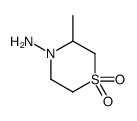23256-30-6
| Name | (E)-N-(3-methyl-1,1-dioxo-1,4-thiazinan-4-yl)-1-(5-nitrofuran-2-yl)methanimine |
|---|---|
| Synonyms |
EINECS 245-531-0
4-Thiomorpholinamine,3-methyl-N-((5-nitro-2-furanyl)methylene)-,1,1-dioxide Lampit Nifurtimoxum [INN-Latin] Bayer 2502 BAY 2502 Nifurtimox [INN:BAN] 4-(5-nitro-furfurylidene)amino-3-methylthiomorpholine 1,1-dioxide NIFURTIMOX 3-methyl-4-[(5-nitrofurfurylidene)amino]thiomorpholine-1,1-dioxide 3-methyl-N-[(5-nitro-2-furanyl)methylene]-4-thiomorpholinamine-1,1-dioxide |
| Description | Nifurtimox, an antiprotozoal agent, which is generally used for the treatment of infections with Trypanosoma cruzi, has been used in the therapy of neuroblastoma. Nifurtimox affects enzyme activity of lactate dehydrogenase (LDH). |
|---|---|
| Related Catalog | |
| Target |
Trypanosoma cruzi[1] Lactate dehydrogenase (LDH) [1] |
| In Vitro | Nifurtimox affects enzyme activity of lactate dehydrogenase (LDH). To differentiate if this effect is a result of a reduced LDH activity or a shift in pyruvate metabolism due to activation of PDH, the enzyme activity of LDH is determined after 4 h treatment with 50 µg/mL Nifurtimox. Compared to the untreated control, the LDH activity is significantly reduced for LA-N-1 (P=0.005), IMR-32 (P=0.009), LS (P=0.0035) and SK-N-SH (P=0.0065). Nifurtimox reduces cell viability and induces cell cycle arrest and apoptosis in neuroblastoma cells. To characterize the cytotoxic impacts of Nifurtimox on neuroblastoma, 4 cell lines are subjected to several experiments. Cell viability is reduced for all 4 neuroblastoma cell lines after 24 h incubation with 50 µg/mL to an average of 66%, 63%, 62% and 75% (LA-N-1, IMR-32 LS and SK-N-SH, respectively). The reduction is significant compared to the untreated control (P<0.01) and the vehicle control with DMSO (P<0.05) for all cell lines[1]. |
| Cell Assay | The Neuroblastoma cell lines IMR-32, LA-N-1 and SK-N-SH and the neuroblastoma cell line LS are grown in RPMI-1640 medium supplemented with 10% (v/v) fetal calf serum (FCS), 2 mM L-glutamine, 100 U/mL Penicillin and 100 µg/mL Streptomycin and incubated at 37°C, 5% CO2 and saturated humidity. To assess the cell viability after incubation with Nifurtimox at different concentrations (10 µg/mL up to 50 µg/mL or 34.8 µM to 174 µM, respectively in the supernatant growth medium) or the vehicle control with according concentrations, all neuroblastoma cell lines are subjected to an MTS assay. Stock solutions of MTS are made at 480 µM in sterile filtered deionized water and stored at -20°C. Cells are grown to approximately 50% confluency, treated with Nifurtimox, and incubated for 1 h with fresh media containing 12 µM MTS[1]. |
| References |
| Density | 1.56g/cm3 |
|---|---|
| Boiling Point | 550.3ºC at 760mmHg |
| Molecular Formula | C10H13N3O5S |
| Molecular Weight | 287.29200 |
| Flash Point | 286.6ºC |
| Exact Mass | 287.05800 |
| PSA | 117.08000 |
| LogP | 2.18250 |
| Vapour Pressure | 3.7E-12mmHg at 25°C |
| Index of Refraction | 1.653 |
| Storage condition | 2-8℃ |
CHEMICAL IDENTIFICATION
HEALTH HAZARD DATAACUTE TOXICITY DATA
MUTATION DATA
|
| RIDADR | NONH for all modes of transport |
|---|
|
~% 
23256-30-6 |
| Literature: WO2007/108947 A2, ; Page/Page column 49 ; |
| Precursor 2 | |
|---|---|
| DownStream 0 | |

